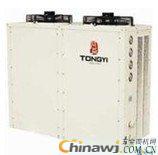Ground-source heat pumps are an innovative and eco-friendly technology that utilize the stable temperature of shallow ground or groundwater to provide heating and cooling for buildings. This system works by exchanging heat between a conventional air conditioning unit and the ground through a closed-loop system, often using a heat transfer fluid as the medium. By tapping into this low-temperature energy source, it offers a highly efficient and sustainable way to manage indoor climate conditions.
According to the "GB50176-1993 Code for Thermal Design of Civil Buildings," in regions with hot summers and cold winters, the number of cooling and heating days is roughly equal, meaning the heating and cooling loads are balanced. This makes ground-source heat pump systems particularly effective, as they can leverage the natural thermal storage capacity of the ground for both heating and cooling. Due to its efficiency and environmental benefits, this technology is widely regarded as one of the most promising HVAC solutions of the 21st century.
In China, much of the current research focuses on direct-buried underground heat exchangers, which are a critical component of ground-source heat pump systems. As the application of heat pump technology becomes more advanced, the design and performance of these underground heat exchangers have become key areas of study. This article presents the author’s experience and findings from a geothermal heat pump project in Changchun City, focusing on geotechnical design and construction practices.
Engineering drilling is a crucial phase in the installation of underground heat exchangers. These pipes are typically installed at depths ranging from 40 to 100 meters, making the process relatively straightforward. Commonly used equipment includes engineering survey drills or shallow core drilling rigs. Table 1 outlines several typical drilling rigs along with their main specifications.
The drilling method is generally simple, with either positive or reverse circulation rotary drilling being commonly used. Before starting, it's essential to understand the site's geological conditions and identify any existing underground utilities. Any issues encountered during drilling, such as borehole collapse, should be addressed promptly to ensure the safety and integrity of the entire system.
Site preparation involves clearing the area of vegetation, debris, and loose soil, and accurately marking the location of each borehole. To manage slurry overflow during grouting, drainage channels are often pre-installed, leading to a settling tank where the mud can be collected and later used as backfill after sedimentation.
Environmental protection is a top priority, especially when dealing with antifreeze leakage risks. In loose Quaternary formations, casing must be properly installed to prevent contamination. Therefore, the hole structure should be carefully planned based on the results of preliminary geological surveys.
When installing ground-source heat pumps in northern regions, the depth of buried pipes should be determined according to local frost penetration depth. For example, in Changchun, where the frozen soil depth ranges from 140 cm to 170 cm, horizontal pipes are usually buried around 250 cm deep. In southern regions, where seasonal variations and biological activity are more significant, pipe burial depths are generally less than 100 cm.
The U-tube connection method plays a vital role in ensuring the system's long-term performance. The buried pipes must be chemically stable, corrosion-resistant, and have good thermal conductivity. Hot-melt welding is the preferred technique for connecting U-tubes. This process involves trimming, cleaning, aligning, and heating the ends until they melt and fuse together. The resulting joint is stronger than the original material, eliminating the risk of corrosion and meeting industry standards.
There are two main hot-melt techniques: socket welding and butt welding. Socket welding involves inserting the ends of the U-tubes into a larger fitting, while butt welding heats both ends simultaneously before joining them. Each joint needs only one heating cycle, and after welding, the tubes must be cooled in a coaxial position for about 20 seconds to ensure proper fusion. During winter installations, it's recommended to perform this process indoors to avoid cold-weather complications.
Lowering the U-tubes into the borehole immediately after drilling is essential to prevent sediment buildup, which can reduce the effective depth of the hole. This step is critical for the success of the system and requires careful handling. Although not yet fully automated, the process still relies heavily on manual labor, with workers responsible for positioning, lowering, and securing the pipes. Maintaining alignment and avoiding close contact between the pipes helps prevent a "short circuit" in the heat exchanger.
Once the U-tubes are in place, they must be secured to prevent floating and the ends sealed to keep out debris. Grouting is then performed to fill the space around the pipes, ensuring proper thermal contact with the surrounding ground. The grout mixture—typically composed of cement, bentonite, sand, and water—is prepared and injected under pressure. The grouting process continues until the slurry level stabilizes, indicating that the hole is fully filled.

staircase light; outdoor step lightings; step wall recessed lights
HSONG LIGHTING CO,. LTD , https://www.hsonglighting.com